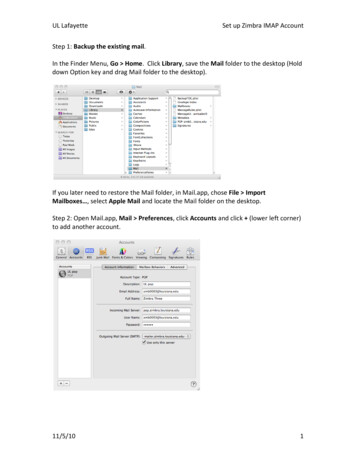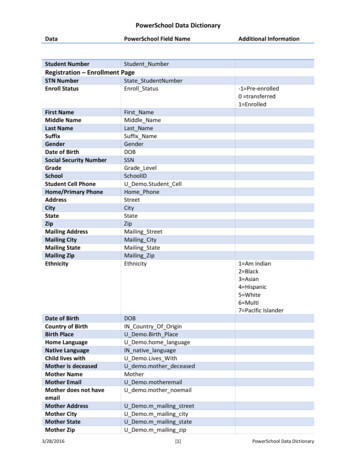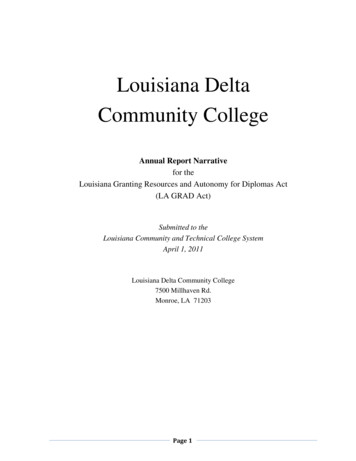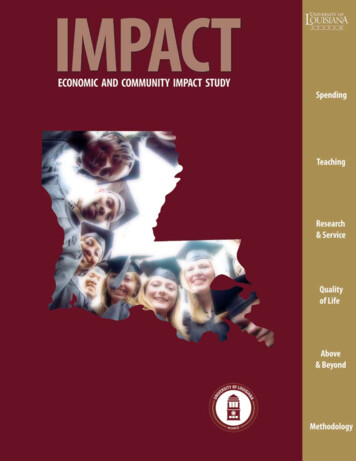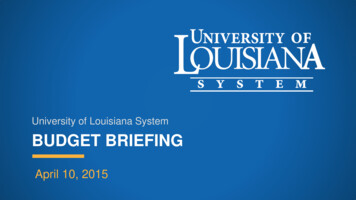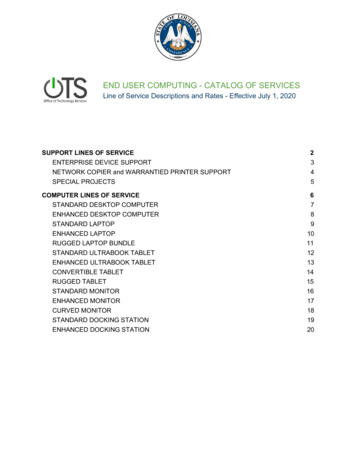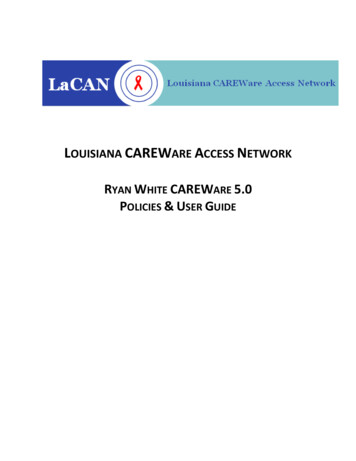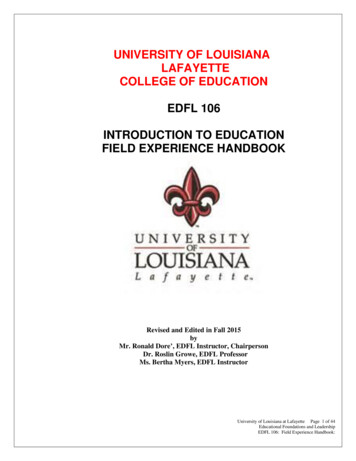
Transcription
UNIVERSITY OF LOUISIANALAFAYETTECOLLEGE OF EDUCATIONEDFL 106INTRODUCTION TO EDUCATIONFIELD EXPERIENCE HANDBOOKRevised and Edited in Fall 2015byMr. Ronald Dore’, EDFL Instructor, ChairpersonDr. Roslin Growe, EDFL ProfessorMs. Bertha Myers, EDFL InstructorUniversity of Louisiana at Lafayette Page 1 of 44Educational Foundations and LeadershipEDFL 106: Field Experience Handbook:
Field experiences are an integral component of University of Louisiana at Lafayette’s TeacherEducation Program. As stated in College of Education’s Field Experience Handbook, the FieldExperience Program is in direct correlation with LTCPS (Louisiana Teacher Competencies andPerformance Standards), INTASC (Interstate New Teacher Assessment and Support Consortium),and NBPTS (National Board for Professional Teaching Standards) standards.The Field Experience Program “provides teacher candidates with systematic and realistic contactswith teaching in K-12 instructional settings before student teaching. Field experiences enrichacademic coursework by providing candidates with opportunities to observe and participate in theday-to-day life of instruction at participating schools and related instructional settings. Throughreflection, candidates begin to learn how to implement and demonstrate expertise in knowledge andpractice in real world environments. Field experiences promote awareness and understanding ofdiversity in the community. In addition, it is through field experiences that candidates begin theirlifelong commitment to ongoing professionalism as they learn to engage in service, advocacy,collaboration, and leadership. Through this process, the teacher candidate is integrated into theCollege of Education’s Conceptual Framework of “The Responsive Professional” (LA Board ofRegents & Board of Elementary and Secondary Education, 2001). Additionally, field experienceopportunities “allow teacher candidates to experience both early and continuing field-based viewpoints in which they may observe, assist, tutor, instruct, and interact with students, teachers, relatedservice providers and administrators.The overall objective of the Field Experience Program is tohelp teacher candidates develop and demonstrate the knowledge, skills, and dispositions that willenable them to become master teaching professionals.For this course, EDFL 106 - Introduction to Education, the field experiences will consist of 10hours of classroom observations in participating schools or other assigned entities (asdetermined by the instructor) and 20 hours of completing worksheets, viewing videos andinputting the information in PassPort as well as writing a teaching philosophy paper in Portal II,totaling 30 hours. The following Competencies/Standards/Descriptors will be considered foryour professional enrichment and partial fulfillment of the requirements of this course: The teacher plans effectively for instruction by creating a physical, intellectual, andemotional environment that promotes high academic expectations and stimulates positive,inclusive, and respectful interactions.The teacher also plans effectively for instruction by including visual aids and technologyto assist in lesson presentations and the learning process.The teacher maximizes the amount of time available for instruction.The teacher manages learner behavior by establishing a positive rapport with thestudents.The teacher also manages learner behavior through the development and implementationof classroom rules in order to provide productive learning opportunities for all students.The teacher maintains an environment conducive to learning by implementing routines,procedures, and structures that promote learning and individual responsibility.The teacher delivers instruction effectively by presenting accurate and developmentallyappropriate content linked to real-life experiences, prior knowledge, and otherdisciplines.The teacher also provides opportunities for student involvement in the learning processthrough the employment of higher order thinking activities, questioning techniques andUniversity of Louisiana at Lafayette Page 2 of 44Educational Foundations and LeadershipEDFL 106: Field Experience Handbook:
academic feedback that lead to mastery of learning objectives and develop students’thinking and problem-solving skills.The teacher delivers lessons that are appropriately structured and paced and includeslearning activities that meet the needs of all students and lead to student mastery ofobjectives.The 10 hours of classroom observations will consist of objectives that will be met through the useof various strategies and resources with evidence of completion as designated for each competency.The general framework will include following the procedures set forth in the EDFL 106 Handbook;on-line activities; viewing of video clips; classroom observations; written follow-ups from classroomobservations; and grading rubrics for classroom observations.REVISED: All materials necessary for the course have been placed on the College ofEducation website, education.louisiana.edu . Click on Current Students, PASS-Port Office,“EDFL 106-Resources.” In addition, all course materials are also available in PASSPORT atthe top of the screen as soon as you login.Participation in field experiences requires that specified expectations, rules, and responsibilities beadhered to in order to establish procedural uniformity, guidance, and productive outcomes as a resultof compliance to the following Field Experience guidelines:Dress Code: Should be appropriate, professional, and conservative. Always follow the dresscode regulations of your particular school and related instructional settings.Procedures for Visits to School and Related Instructional Settings ( as stipulated by the“Guidelines for Participating in Field Experiences” in the University of Louisiana atLafayette College of Education Field Experience Handbook (2004):Teacher candidates are required to: Arrive at the school or related instructional setting early enough to sign in at thefront office. Be in the classroom or instructional setting at least 10 minutesbefore instruction begins. Wear your UL Lafayette personal ID at all times while at the schoolcampus/related instructional setting. Sign in at the front office. You may be given a visitor’s pass. Wear the passat all times while on the school campus or related instructional setting. Know and adhere to the policies, practices, and procedures of theschool- related instructional setting. You must respect, know, and adhere to therules, regulations of that school/related instructional setting. In an emergency only, if you should be unable to keep your appointment, call theschool/related instructional setting and ask the receptionist to tell the cooperating teacheror related service provider that you are unable to report. Call or email your universitycourse instructor with your reason for not reporting as scheduled.University of Louisiana at Lafayette Page 3 of 44Educational Foundations and LeadershipEDFL 106: Field Experience Handbook:
Not wear headgear, chew gum, use tobacco products, cell phones and pagers,have food, and drink (including water) in any instructional settings. All areexpressly prohibited. Obtain special permission for any photography, videotaping, oraudio taping.Dispositions for Teacher CandidatesTeacher candidates must: Be mentally and physically prepared daily for responsibilities and obligations ofthe profession. Recognize that teaching is a profession that requires them to be honest anddedicated individuals of integrity. Be flexible, versatile, and respond positively to suggestions, assignments, andsupervision. Treat students and school/related instructional setting personnel with respect atall times. Reflect the ethical standards of the University, the school system, relatedinstructional setting, and the teaching profession.Additional dispositions required by teacher candidates: Keep all student-related data confidential which is a professionalrequirement. Send a “thank-you” note to both the cooperating teacher/relatedprofessionals and the principal/related service provider.As stated in Act 54, namely Designing Louisiana’s Comprehensive Evaluation Model (COMPASS), researchshows that the efficacy of teachers and school leaders to be the most important school related factor affectingstudent performance. Therefore, to advance K-12 public education, the most powerful lever is to support andadvance the capacity of teachers to improve student achievement. Fifty percent of an educator’s evaluation isbased on the SITE index which is multi-dimensional and based on traditional evaluation techniques, such asclassroom observations. Through each student’s completed field experiences, portfolios will provideinformation that reflects the student’s understanding of what entails a teacher’s understanding and ability toteach effectively; to identify strengths and weaknesses of the lessons; and to improve instruction for thebenefit of students.University of Louisiana at Lafayette Page 4 of 44Educational Foundations and LeadershipEDFL 106: Field Experience Handbook:
Table of ConceptsFEX 1: Teacher Creates a Physical, Intellectual, and Emotional Environment that PromotesHigh Academic Expectations and Stimulates Positive, Inclusive, and Respectful arationField ExperienceEntering Field Experience into PASS-PORTWebsite Evaluation (Zimbra)Teacher-Student Rapport WorksheetTeacher Creates Environment Rubric Parts 1-2Classroom Diagram WorksheetObservation RubricPage 7FEX 2: The Teacher Implements Routines, Procedures, and Structures that PromoteLearning and Individual ResponsibilityObjectivesPage 16RequirementsIntroductionPreparationField Experience InformationRoutines/Transitions RubricResourcesLesson Initiation/Closure WorksheetEntering Field Experience into Pass-PortFEX 3: The Teacher Presents Accurate and Developmentally-Appropriate Content Linked toReal-Life Examples, Prior Knowledge, and Other DisciplinesObjectivesPage 22RequirementsIntroductionPreparationField Experience InformationEntering Field Experience into PASS-PORTWebsite Evaluation (Moodle)Teacher Provides Content Linked to Real-Life ExamplesObservation Rubric Parts 1-2Teacher Delivers Instruction Effectively WorksheetFEX 4: The Teacher Uses a Variety of Effective Instructional Strategies, QuestioningTechniques, and Academic Feedback That Lead to Mastery of Learning Objectives andDevelop Students’ Thinking and Problem-Solving SkillsUniversity of Louisiana at Lafayette Page 5 of 44Educational Foundations and LeadershipEDFL 106: Field Experience Handbook:
ObjectivesPage 29RequirementsIntroductionPreparationField ExperienceResourcesEntering Field Experience into PASS-PORTHigh-Order Thinking Skills WorksheetTeacher Stimulates and Encourages High-Order Thinking SkillsRubric Parts 1-2Visual Aids/Technology Rubric Part 2Technology Integration WorksheetFEX 5: The Teacher Delivers Lessons That are Appropriately Structured and Paced andIncludes Learning Activities That Meet the Needs of All Students and Lead to Student Masteryof ObjectivesObjectivesPage 37IntroductionPreparationField ExperienceEntering Field Experience into PASS-PORTWebsite EvaluationTeacher Maximizes Student Achievement and Meets Individual NeedsNeedsObservation Rubric Parts 1 & 2ENVIRONMENT COMPETENCY: The teacher provides a well-managed, student-centeredclassroom that promotes and reinforces student achievement, academic engagement, andmutual respect.University of Louisiana at Lafayette Page 6 of 44Educational Foundations and LeadershipEDFL 106: Field Experience Handbook:
STANDARD 1: The teacher creates a physical, intellectual, and emotional environment thatpromotes high academic expectations and stimulates positive, inclusive, and respectfulinteractions.Descriptor 1:Descriptor 2:Descriptor 3:Descriptor 4:Organizes available space, materials, and/or equipment to facilitate learningPromotes a positive learning climateEstablishes expectations for learner behaviorUses monitoring techniques to facilitate learningCOMPASS- Complete Framework for Teaching InstrumentDomain 2: The Classroom Environment2c: Managing classroom proceduresIndicators include: Smooth functioning of all routines Little or no loss of instructional time Students playing an important role in carrying out the routines Students know what to do, where to moveFEX 1: TEACHER CREATES ENVIRONMENT PROMOTINGHIGH ACADEMIC EXPECTATIONS AND POSITIVEINTERACTIONObjectives: Discuss the prerequisites for promoting a classroom environment conducive to studentlearning. Compare effective learning climates with ineffective learning atmospheres.Requirements: (Listed Under SUBJECTS BY HOUR)Preparation Time: (Enter the total of the following in SUBJECTS BY HOUR UNDER“OTHER”Videos:.50 hourWebSite Evaluation:.50 hourClassroom Diagram.50 hourCompletion of Worksheets1 .00 hourReflection & Rubrics 1 & 21 .50 hour(TOTAL PREPARATION TIME)4.0 hoursField Observation: (Enter the total in SUBJECTS BY HOUR)Total Field Experience6.0 hours2.0 hoursIntroduction:A goal of teaching is to ensure the learning of students. There are several ways to ensure that thelearning environment in a classroom is one in which students will thrive and learn. The organizationUniversity of Louisiana at Lafayette Page 7 of 44Educational Foundations and LeadershipEDFL 106: Field Experience Handbook:
of the teacher, the teacher’s enthusiasm towards the students and the subject matter, the rapportbetween the teacher and the students, and the availability of resources all play a part in creating theoverall learning environment. Moreover, creating a positive rapport with your students is vital in thesuccess of the teaching-learning experience, and it will make your job easier. Important componentsinvolved in establishing a positive rapport with your students are communication, the teacher asmodel, and positive expectations.Preparation: Teacher Candidates will view the video “High Expectations: Students Learn to Rise tothe Occasion” Visit the WebPage at education.louisiana.edu.lesson.Complete the Website Evaluation located in thisDescriptor 1: Organizing available space to facilitate learningStrategy 1: Have equipment available and ready for use prior to the lesson.Strategy 2: Check equipment and prepare aids/or materials at the beginning of the day or atthe end of the previous day.Strategy 3: Successful teachers have a contingency plan that can be used when equipmentproblems occur.Strategy 4: Establish a system for sharing books or materials when they are in short supply.Strategy 5: Create a “to do list” to remember the materials, aids, and/or equipment needed forthe next day’s lesson.Strategy 6: Evaluate the current arrangement of your classroom in terms of safety andpracticality. Is it arranged in such a way so students can function duringteaching and learning?Strategy 7: Complete a safety check of your classroom and note any unsafe areas.Strategy 8: Utilizing the classroom space to facilitate learning includes using the walls,bulletin boards, and other display safe.Strategy 9: Involve students in creating content-related classroom displays.Strategy 10: Invite the principal or a peer teacher to look at displays in your classroom andprovide feedback.Strategy 11: Have a display area for students’ work. Have something from each studentdisplayed.Strategy 12: Evaluate the current arrangement of your classroom in terms of learningefficiency. Are the traffic patterns arranged in a way to allow for efficientmovement of the teacher and students? In group- work, are group sizes suitablefor the physical arrangement?Strategy 13: Visit the classrooms of two peer teachers and diagram the room arrangements.Strategy 14: Arrange your classroom in a different manner for at least one week. At the endof the week, list the pros and cons for leaving the classroom arranged in thismanner, returning it to the original arrangement, or modifying the newarrangement.Strategy 15: Read at least one professional publication on classroom environments.Descriptor 2: Promotes a positive learning climateUniversity of Louisiana at Lafayette Page 8 of 44Educational Foundations and LeadershipEDFL 106: Field Experience Handbook:
Strategy 1: There are many indicators of a positive classroom climate. Courtesy, respect,warmth, and friendliness among students and teacher are some of theseindicators.Strategy 2: The teacher serves as a powerful role model for demonstrating pro-socialbehaviors. Note ways you demonstrate or could have demonstrated sensitivity tothe needs and feelings of others in your classroom.Strategy 3: Ask a peer teacher to observe you as you teach a lesson. The peer teacher shouldnote ways you demonstrated awareness of climate in the classroom that mayinclude using student names, maintaining eye contact while interacting verballywith students, and speaking in a positive tone of voice.Strategy 4: Record in writing ways you demonstrated courtesy, respect, warmth andfriendliness.Strategy 5: Appoint a student in each class as a “climate watcher” to assess the classroomclimate, and have that student complete a chart depicting the environment of theclassroom.Strategy 6: Work with students cooperatively to make a list of positive and encouragingexpressions to be used in the classroom.Strategy 7: Practice using the phrases on the list of “ways to Say ‘Good’” and “Positive Waysto say ‘You can do better’”Strategy 8: Make a list of ways enthusiasm for teaching, learning, and subject matter can becommunicated to students in the classroom.Strategy 9: View a peer teacher demonstrating enthusiasm. List ways the teachercommunicated enthusiasm for teaching, learning, and the subject being taught tothe students.Strategy 10: Over a period of several days, write statements in your lesson plans indicatinghow you can demonstrate enthusiasm for teaching, learning, and the subjectmatter.Strategy 11: Rate yourself on the “enthusiasm checklist” and then outline a plan to improveyour rating.Descriptor 3: Establishes expectations for learner behaviorDescriptor 4: Uses monitoring techniques to facilitate learningField Experience: Schedule a 2 hour observation period in a classroom. Read through all of the followingactivities before arriving at your observation site. Review the Classroom Diagram Worksheet and the Teacher-Student RapportObservation Worksheet and Rubric before you arrive at the site. Complete the following activities during the observation:o Create a schematic drawing of the classroom arrangement noting desks, resources,and traffic areas. If the class breaks into small groups, diagram the classroomarrangement when groups are used. You may wish to use the Classroom DiagramWorksheet provided at the end of this lesson.o Write down any positive or negative instances that you observe that may affect thelearning climate.o Note resources that were utilized throughout the lesson as seen in the video.University of Louisiana at Lafayette Page 9 of 44Educational Foundations and LeadershipEDFL 106: Field Experience Handbook:
o Note the rapport between the teacher and the students. Positive? Negative?After the observation:o Complete the Teacher Creates Environment that Promotes High AcademicExpectations Field Experience in PASS-PORT. A copy of the form is located at theend of this lesson to assist you with collecting the information to enter.Resources:Additional Resources (for your consideration)Buskist, W. & Saville, K. (2001). Rapport-building: creating positive emotional contexts forenhancing teaching and learning. American Psychological Society, Vol. 14, No.3. Retrieved July20, 2005 from tips 0301.htmlHawley, C. (1997). Building rapport with students. Teacher Talk. Retrieved July 20, 2005from http://education.indiana.edu/cas/tt/v3i1/tips st.htmlPositive Classroom Environment and Student-Teacher R
Lafayette College of Education Field Experience Handbook (2004): . Be in the classroom or instructional setting at least 10 minutes before instruction begins. Wear your UL Lafayette personal ID at all times while at the school campus/rel
